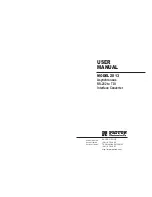
MNL940-003-000-
13
4.0 OPERATIONAL
CONSIDERATIONS
4.1 LOADING
LIMITATIONS:
The INV series are designed to produce a power level of 1200 Watts ( real power) under
continuous operating conditions. In addition, they can supply bursts of over 1500 watts
for several seconds. Peak repetitive currents on the order of 60 amps may also be
supplied
continuously as long as they do not exceed the RMS value of 10 amps.
This high peak current capability allows the INV 1210 series to start most high in - rush
loads. It must be understood that the DC power source suppling the inverter must also
have this capability in order to derive these benefits. A poorly regulated or high internal
resistance DC power source will affect operation of the inverter.
4.2
POWERING REACTIVE LOADS
Capacitors and inductors are reactive in nature. If the load is applied during the peak of
the AC cycle there may be a considerable in rush of current several magnitudes larger
than the steady state current. This current is only limited by any series resistance that may
be present in the load circuit. Under the right conditions, this could trip the overload
protection circuits in the inverter.
Several methods can be used to prevent tripping the protection circuits in the power
source . One common method is to insert a limiting impedance in series with the load.
This could be in the form of a fixed resistor or NTC (negative temperature coefficient)
thermistor. Also, zero crossing switching can be employed.
Loads with a large parallel capacitance will draw large current spikes during the edge
transitions of the output waveform. This may generate EMI (electro-magnetic
interference). Also, loads that are pure inductors will produce “ringing” on the edges of
the output waveform which will also cause EMI. If the load to be supplied are purely
capacitive or inductive, the Behlman model INV1200 should be considered. The model
1200 produces a sinewave output.
4.3 POWERING
LAMPS
Tungsten filaments lamps, when cold, present a very low resistance. Once they are
energized, their resistance quickly climbs to it’s steady state value. This characteristic
must be accounted for when driving tungsten filament lamps. The same methods for
driving reactive loads can be applied to tungsten.
4.4 POWERING
MOTORS
Driving an AC motor presents a special problem. Most motors require a starting current
that is several times higher than the running current. This current may last for a few
cycles to several seconds depending on the construction and mechanical load on the
motor. This current is sometimes referred to as the motor’s “locked rotor” current. This
current is not to be confused with the in- rush current that usually occurs over the course
of one or two cycles of the AC waveform.





































